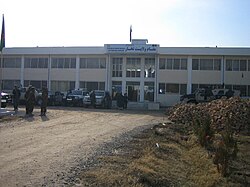Taloqan تالقان | |
|---|---|
 Takhar governor's office in Taloqan | |
| Coordinates: 36°43′N69°31′E / 36.717°N 69.517°E | |
| Country | |
| Province | Takhar |
| District | Taloqan |
| Government | |
| • Type | Municipality |
| Area | |
| • Land | 107 km2 (41 sq mi) |
| Elevation | 876 m (2,874 ft) |
| Population (2025) [3] | |
| 284,990 | |
| • Urban | 94,438 |
| • Rural | 190,552 |
| Time zone | UTC+04:30 (Afghanistan Time) |
| ISO 3166 code | AF-TQN |
Taloqan, [a] also written as Taleqan or Taluqan, [4] is a city in northern Afghanistan, serving as the capital of Takhar Province. [5] [6] It is within the jurisdiction of Taloqan District and has an estimated population of 284,990 people. [3] Ethnically, they are Tajiks, Uzbeks, Pashtuns and Hazaras.
Contents
Taloqan is home to Takhar University, which is in the northwestern part of the city. The Taloqan Airport is a few miles to the north. The city has a number of bazaars, business centers, public parks, banks, hotels, restaurants, mosques, hospitals, universities, and places to play sports or relax.
Taloqan sits at an altitude of 876 m (2,874 ft) above sea level, [2] and has a land area of 107 km2 (41 sq mi) with 28,691 dwelling units in it. [1] The city is administratively divided into 6 city districts (nahias). [2] There is a major road that passes through the city, linking it with nearby Kunduz in the west and Fayzabad in Badakhshan Province in the northeast.


